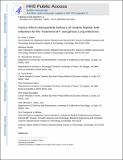| dc.contributor.author | Kwon, Ester J | |
| dc.contributor.author | Skalak, Matthew | |
| dc.contributor.author | Bertucci, Alessandro | |
| dc.contributor.author | Braun, Gary | |
| dc.contributor.author | Ricci, Francesco | |
| dc.contributor.author | Ruoslahti, Erkki | |
| dc.contributor.author | Sailor, Michael J | |
| dc.contributor.author | Bhatia, Sangeeta N | |
| dc.date.accessioned | 2021-10-27T20:24:17Z | |
| dc.date.available | 2021-10-27T20:24:17Z | |
| dc.date.issued | 2017 | |
| dc.identifier.uri | https://hdl.handle.net/1721.1/135620 | |
| dc.description.abstract | © 2017 WILEY-VCH Verlag GmbH & Co. KGaA, Weinheim There is an urgent need for new materials to treat bacterial infections. In order to improve antibacterial delivery, an anti-infective nanomaterial is developed that utilizes two strategies for localization: i) a biodegradable nanoparticle carrier to localize therapeutics within the tissue, and ii) a novel tandem peptide cargo to localize payload to bacterial membranes. First, a library of antibacterial peptides is screened that combines a membrane-localizing peptide with a toxic peptide cargo and discovers a tandem peptide that displays synergy between the two domains and is able to kill Pseudomonas aeruginosa at sub-micromolar concentrations. To apply this material to the lung, the tandem peptide is loaded into porous silicon nanoparticles (pSiNPs). Charged peptide payloads are loaded into the pores of the pSiNP at ≈30% mass loading and ≈90% loading efficiency using phosphonate surface chemistry. When delivered to the lungs of mice, this anti-infective nanomaterial exhibits improved safety profiles over free peptides. Moreover, treatment of a lung infection of P. aeruginosa results in a large reduction in bacterial numbers and markedly improves survival compared to untreated mice. Collectively, this study presents the selection of a bifunctional peptide-based anti-infective agent and its delivery via biodegradable nanoparticles for application to an animal model of lung infection. | |
| dc.language.iso | en | |
| dc.publisher | Wiley | |
| dc.relation.isversionof | 10.1002/ADMA.201701527 | |
| dc.rights | Creative Commons Attribution-Noncommercial-Share Alike | |
| dc.rights.uri | http://creativecommons.org/licenses/by-nc-sa/4.0/ | |
| dc.source | PMC | |
| dc.title | Porous Silicon Nanoparticle Delivery of Tandem Peptide Anti‐Infectives for the Treatment of Pseudomonas aeruginosa Lung Infections | |
| dc.type | Article | |
| dc.contributor.department | Koch Institute for Integrative Cancer Research at MIT | |
| dc.contributor.department | Harvard University--MIT Division of Health Sciences and Technology | |
| dc.contributor.department | Massachusetts Institute of Technology. Institute for Medical Engineering & Science | |
| dc.contributor.department | Massachusetts Institute of Technology. Department of Electrical Engineering and Computer Science | |
| dc.contributor.department | Howard Hughes Medical Institute | |
| dc.relation.journal | Advanced Materials | |
| dc.eprint.version | Author's final manuscript | |
| dc.type.uri | http://purl.org/eprint/type/JournalArticle | |
| eprint.status | http://purl.org/eprint/status/PeerReviewed | |
| dc.date.updated | 2019-05-09T16:26:23Z | |
| dspace.orderedauthors | Kwon, EJ; Skalak, M; Bertucci, A; Braun, G; Ricci, F; Ruoslahti, E; Sailor, MJ; Bhatia, SN | |
| dspace.date.submission | 2019-05-09T16:26:24Z | |
| mit.journal.volume | 29 | |
| mit.journal.issue | 35 | |
| mit.metadata.status | Authority Work and Publication Information Needed | |
